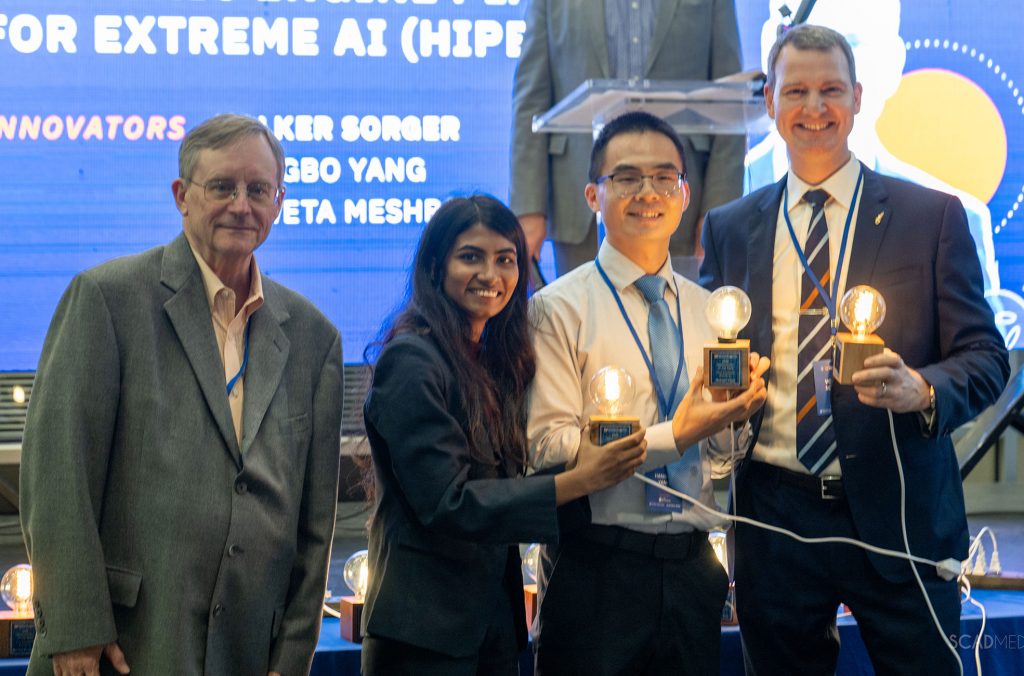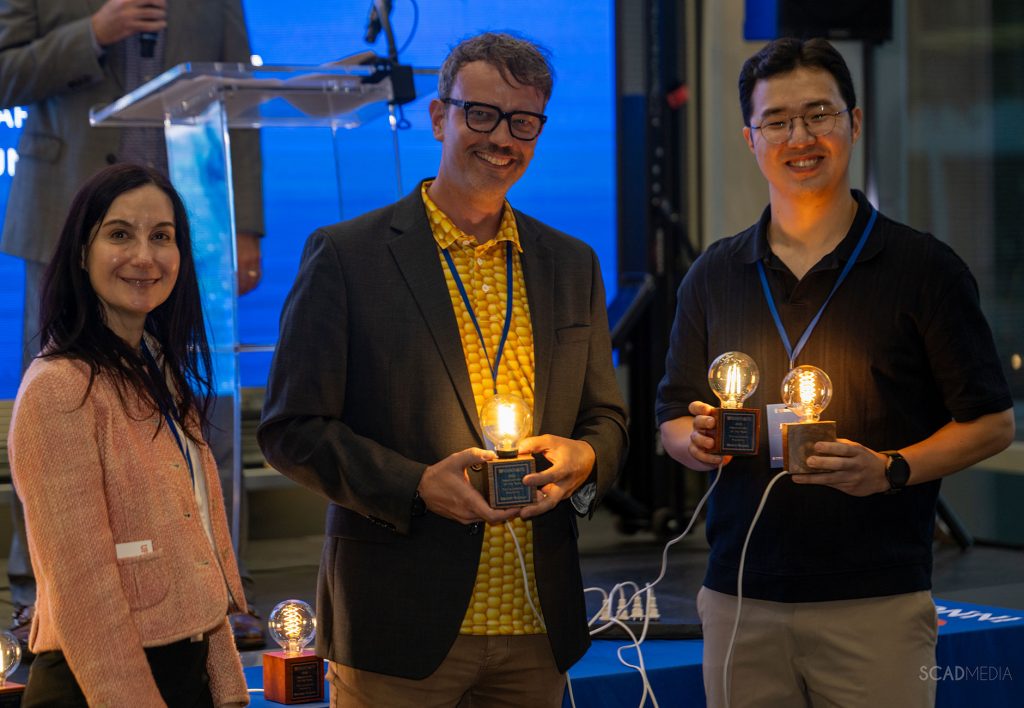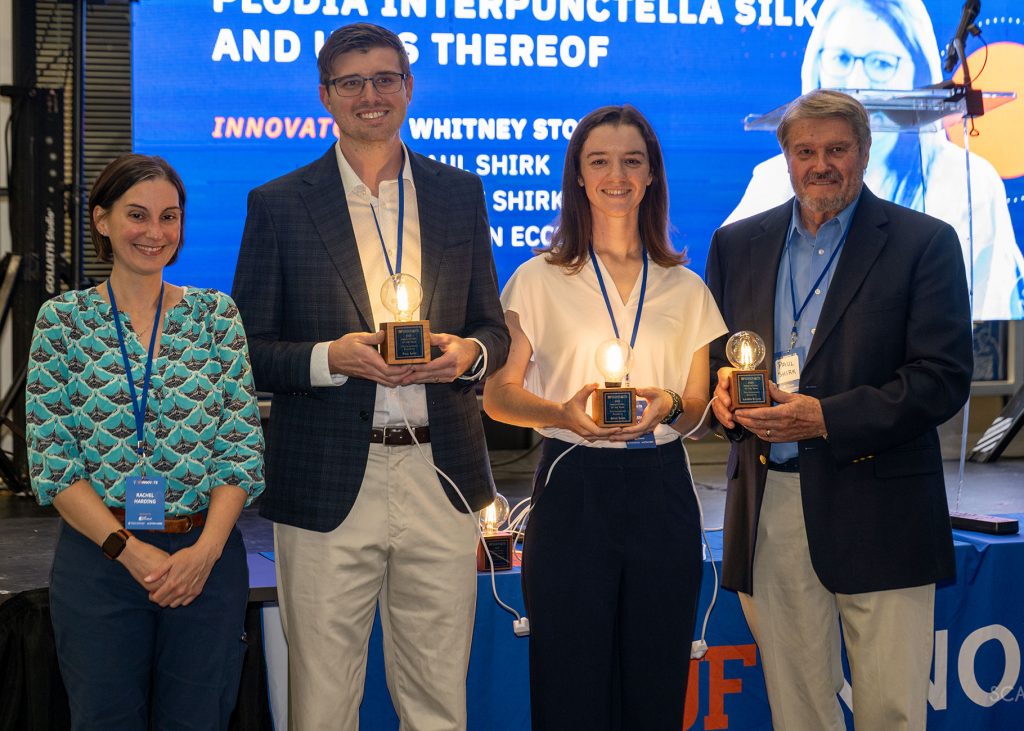Share
Gator Engineering faculty take home four inventions of year from UF Innovate
Innovation was in the spotlight last week as UF Innovate | Tech Licensing celebrated the top six innovations of 2025 at its annual Standing InnOvation event. Four of the recognized technologies came from faculty researchers in the UF Herbert Wertheim College of Engineering.
Volker Sorger, Ph.D, the Walden and Paula Rhines Endowed Professor in Semiconductor Photonics and deputy director of Strategic Initiatives at the Florida Semiconductor Institute, and his research team, Hangbo Yang, Ph.D., a research associate professor, and Shweta Meshram, a graduate student in the Department of Electrical and Computer Engineering; Whitney Stoppel, Ph.D., associate professor and William P. and Tracy Cirioli Term Professor, in the Department of Chemical Engineering, Gregory Hudalla, Ph.D., from the J. Crayton Pruitt Family Department of Biomedical Engineering and Richard Hennig, Ph.D., in the Department of Materials Science and Engineering were recognized for their groundbreaking research discoveries made in fiscal year 2025.
Standing InnOvation honors UF innovators who disclosed, optioned, licensed or had a patent issued in the fiscal year, which ended on June 30. This year’s celebration saw the recognition of 796 innovators, all of whom contributed in some way to 435 new technologies disclosed, 130 licenses, 130 issued patents or the nine new startup companies. The event is billed as a well-deserved “standing ovation” for excellent work.



HIPER-X: Transforming data communication within high-performance computing systems
In the world of high-performance computing, energy efficiency is a major concern. Traditional electrical signals consume a lot of energy, especially in systems used for artificial intelligence and machine learning. Sorger, Yang and Meshram are addressing this concern with HIPER-X.
HIPER-X, which stands for Heterogeneous In-Package Photonic Engine Platform for Extreme AI, uses light to communicate between processing units, reducing energy consumption and increasing efficiency. The revolutionary platform enhances data communication with high-performance computing systems, such as GPUs and CPUs.
“We want to use photonic communication between them to reduce the energy power,” said Yang.
If HIPER-X replaces traditional electrical signals, he said, the total energy consumption can be reduced by 80%.
The team is working to develop this technology further, with plans to increase the number of processing units that can communicate with each other. They are also collaborating with industry partners to apply HIPER-X to next-generation GPU developments.
“Their technology will result in new and improved communication methods, sensor technologies and, ultimately, quantum computing,” said Richard Croley, Ph.D. the licensing officer managing this technology.
Genetically modified plodia interpunctella silk and uses thereof
Therapeutic silk fibers: What are they? Why should you care?
Imagine taking an agricultural pest and turning it into a protein factory — one that produces therapeutic proteins used to treat rare diseases, including cancer. That’s exactly what Stoppel is exploring.
Stoppel and her team, including Paul Shirk, Bryce Shirk and Lauren Eccles, are engineering the Indianmeal moth to produce silk fibers containing therapeutic proteins. These fibers are natural, biocompatible materials that stabilize and protect therapeutic proteins at room temperature, making therapeutic proteins more accessible to patients around the world.
By genetically modifying the silk fibers to entrap therapeutic proteins, the researchers hope to create a system that eliminates complicated and expensive processes like protein-purification systems.
Powered by interdisciplinary research and collaboration, this Invention of the Year has the potential to make a significant impact on medicine and improve lives around the world.
“We’re really excited about the potential of this technology and are working to bring it to market as soon as possible,” said Stoppel.
New one-stop ELISA test speeds up medical diagnoses without refrigeration
ELISA, which stands for enzyme-linked immunosorbent assay, is a widely used test that detects specific proteins or substances in blood or urine samples. However, traditional ELISA tests are time-consuming and complicated. They also often require refrigeration of key materials.
Hudalla, along with colleagues Marcio Resende, Ph.D., and Junha Park, Ph.D. student, developed a new One-Shot ELISA that is faster and easier to use. This diagnostic tool combines the coating protein, blocking agent and secondary antibody, all of which are typically separate steps in a traditional ELISA, into a single freeze-dried package. This simplifies the process, allowing diagnostic testing to occur almost instantly.
One-Shot ELISA uses freeze-drying, also known as lyophilization, to combine all test components into a single, stable package. This preserves the materials without refrigeration, similar to how freeze-dried foods stay fresh, and enables faster results.
The process also incorporates special stabilizers, including PLGA nanoparticles and phytoglycogen, which protect delicate proteins like antibodies during drying and storage. These lyoprotectants help maintain the test’s stability and reliability by preventing protein damage such as denaturation or aggregation. This innovation not only extends shelf life and simplifies operation but also offers greater flexibility for manufacturers and healthcare providers by eliminating the need for cold chain logistics.
AI-accelerated workflow for superconductor discovery
Faster. Smarter. Revolutionary.
These words capture the impact of an invention Hennig and his colleagues, Peter Hirschfeld, Ph.D., in the Department of Physics, and UF’s Jason Gibson, Ph.D., and Ajinkya Hire, Ph. D., focused on as they set out to push the boundaries.
The discovery of superconducting materials, which conduct electricity without resistance, has traditionally been slow and resource heavy. This invention introduces a workflow that applies artificial intelligence to make the discovery process faster and more efficient.
Built around a deep learning system called the Bootstrapped Ensemble of Equivalent Graph Neural Network, or BEE-NET, the model predicts critical temperatures of superconductors using data on crystal structures and phonon density of states. It is trained on different data types, including crystal structure only and coarse phonon density of states, and evaluated with loss functions like mean squared error, weighted mean squared error and Earth Mover’s Distance to improve accuracy and reliability.
The invention combines BEE-NET with machine learning and physics-based simulations to filter materials from large databases based on formation energy, bandgap, critical temperature and energy stability. The most promising candidates are then refined using Density Functional Theory simulations. The workflow has identified over 700 potentially stable superconductors. Two of these materials, Be2HfNb2 and Be2Hf2Nb, have been successfully synthesized and confirmed in the lab.
By combining AI and materials science, this invention brings us closer to next-generation superconductors.
Faculty from UF’s College of Engineering represented 300 innovators who disclosed new technologies and had their technologies patented, optioned, or licensed.
